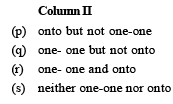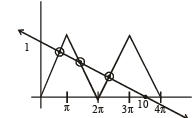JEE Advanced (Matrix Match): Functions | Chapter-wise Tests for JEE Main & Advanced PDF Download
Match the following Question
Direction (Q. 1 and 2) Each question contains statements given in two columns, which have to be matched. The statements in Column-I are labelled A, B, C and D, while the statements in Column-II are labelled p, q, r, s and t. Any given statement in Column-I can have correct matching with ONE OR MORE statement(s) in ColumnII. The appropriate bubbles corresponding to the answers to these questions have to be darkened as illustrated in the following example :
If the correct matches are A-p, s and t; B-q and r; C-p and q; and D-s then the correct darkening of bubbles will look like the given.

Q. 1. Let the function defined in column 1 have domain  and range (-∞,∞)
and range (-∞,∞)


Ans. (A) - q; (B) - r
Solution. (A) f (x) = 1 + 2x, Df = (–π/2, π/2)
The given function represents a straight line so it is one one.

(B) f (x) = tan x It is an increasing function on (–π/2, π/2) and its range
= (–∞,∞) = co-domain of f.
∴ f is one one onto.
∴ (B) → r
Q. 2. 
Match of expressions/statements in Column I with expressions/statements in Column II and indicate your answer by darkening the appropriate bubbles in the 4 × 4 matrix given in the ORS.


Ans. (A) -p, r, s ; (B) - q, s ; (C) - q, s ; (D) -p, r, s
Solution.

Integar Type question
Q. 1. Let f : [0, 4π] → [0, π] be defined by f (x) = cos–1(cos x). The number of points x ∈[ 0,4π] satisfying the equation

Ans. 3
Solution.


The graph of y = f (x) and y = g (x) are as follows.
Clearly f(x) = g(x) has 3 solutions.
|
446 docs|929 tests
|
















